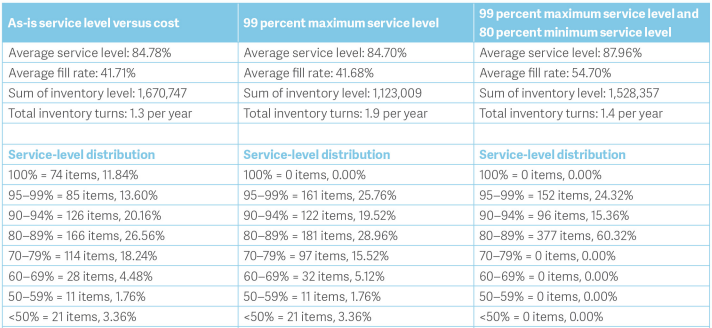Many companies adopt a philosophy of “it’s better to have it and not need it, then to need it and not have it.” Planning initiatives such as implementing inventory optimization software in order to optimize reorder points, safety stocks, and order quantities are often seen as narrowly focused on reducing inventory and not pursued. Stock-out costs may very well be extremely high. However, resources are finite. The opportunity cost of keeping too much of one product means less space, cash, and resources for another product. Overstocking on one item reduces the ability to provide adequate levels of service on other items. Justifying overstocks by stating it is good for the customer is a poor excuse at best that hurts the customer and ignores what inventory optimization is really about – properly reallocating inventory investments.
Diminishing Returns and Inventory
Each additional unit of inventory that you carry buys proportionally less service. Inventory optimization software can help you understand the exact stock out risk given a certain level of stock. For example, say your stock-out risk with 20 units of inventory is 10%. If you add another 10 units and carry 30 units, the stock out risk might get cut in half to 5%. If you then add an additional 10 for a total of 40 units, the stock-out risk may only drop to 4%. At some point, the additional inventory just isn’t worth the extra service it buys. This is especially so if the cash used to buy that extra 10 units to get a small service level bump on one item could have been spent on another equally important item for a larger increase in service.
Carrying more than you need means you aren’t efficiently managing assets, which costs money, which means you can’t offer the best price to your customer, which hurts your ability to beat the competition. It also means there is less money for investment in other items. This results in the common adage “We have too much of the stuff we don’t need and not enough of the stuff we do.”
Inventory Optimization is about reallocation
The example presented in the blog’s main image highlights the benefits of reallocating inventory. We used probability forecasting to estimate the service levels and inventory costs that would result from the current stocking policy. We then conducted a “what-if” scenario by modifying the policy. In the benchmark shown in the first column, the current stock levels were forecasted to yield a 84.78% service level and required $1.67 Million in inventory. Nearly 12% of the items numbers had reached their point of diminishing return and were forecasted to achieve a 100% service level. By imposing a maximum service level of 99% and a minimum service level of 80%, we reallocated inventory. As a result, the inventory investment dropped to $1.5 Million and service level increased by 3%!
The exact point of diminishing returns will differ depending on the item, the customers involved, and the company making the stocking decision. It is important to understand the inherent levels of stock-out risk that result from current inventory policies and how changes to current policies will impact risk and costs. This enables the reshaping of inventory so that service can be maximized at the minimum possible cost.
Download Smart Inventory Optimization product sheet here: https://smartcorp.com/inventory-optimization/
Related Posts

Managing Spare Parts Inventory: Best Practices
In this blog, we’ll explore several effective strategies for managing spare parts inventory, emphasizing the importance of optimizing stock levels, maintaining service levels, and using smart tools to aid in decision-making. Managing spare parts inventory is a critical component for businesses that depend on equipment uptime and service reliability. Unlike regular inventory items, spare parts often have unpredictable demand patterns, making them more challenging to manage effectively. An efficient spare parts inventory management system helps prevent stockouts that can lead to operational downtime and costly delays while also avoiding overstocking that unnecessarily ties up capital and increases holding costs.

12 Causes of Overstocking and Practical Solutions
Managing inventory effectively is critical for maintaining a healthy balance sheet and ensuring that resources are optimally allocated. Here is an in-depth exploration of the main causes of overstocking, their implications, and possible solutions.

FAQ: Mastering Smart IP&O for Better Inventory Management.
Effective supply chain and inventory management are essential for achieving operational efficiency and customer satisfaction. This blog provides clear and concise answers to some basic and other common questions from our Smart IP&O customers, offering practical insights to overcome typical challenges and enhance your inventory management practices. Focusing on these key areas, we help you transform complex inventory issues into strategic, manageable actions that reduce costs and improve overall performance with Smart IP&O.












